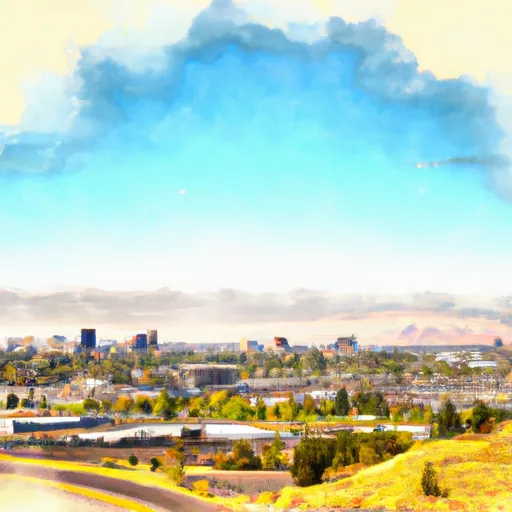-
 Snoflo Premium
Snoflo Premium
Get unlimited access to all our content
With no Ad interruptions! - Start Your Free Trial Login with existing account
Moses-Lake
Eden Index
Climate
8.6
•
Recreation
6.1
•
Community
2.2
•
Safeguard
6.1/10

Moses Lake, Washington, is a small city located in Grant County, in the central part of the state. It experiences a semi-arid climate, characterized by hot, dry summers and cool, relatively mild winters. Summers can be scorching, with average temperatures reaching the high 80s to low 90s Fahrenheit, while winters are generally chilly with average temperatures ranging from the mid-20s to the mid-40s Fahrenheit.
Moses Lake is surrounded by several bodies of water, including its namesake lake, which is the largest natural freshwater lake in Grant County. The lake is a popular spot for fishing, boating, swimming, and water sports. The area is also known for its diverse bird population, making it a great destination for birdwatchers.
For outdoor enthusiasts, Moses Lake offers various recreational opportunities. The nearby Columbia National Wildlife Refuge provides opportunities for hiking, birdwatching, and wildlife photography. The area is also home to several parks and trails, ideal for picnicking, camping, and exploring nature. Additionally, the city has a golf course, community swimming pool, and sports complexes for sports enthusiasts.
Overall, Moses Lake, Washington, provides a pleasant climate, picturesque waters, and diverse outdoor recreation opportunities for residents and visitors alike.
What is the Eden Index?
The Snoflo Eden Index serves as a comprehensive rating system for regions, evaluating their desirability through a holistic assessment of climate health, outdoor recreation opportunities, and natural disaster risk, acknowledging the profound impact of these factors on livability and well-being.
Climate Health Indicator (CHI): 8.6
Moses-Lake receives approximately
204mm of rain per year,
with humidity levels near 64%
and air temperatures averaging around
11°C.
Moses-Lake has a plant hardyness factor of
6, meaning
plants and agriculture in this region thrive during a short period during spring and early summer. Most
plants will die off during the colder winter months.
By considering the ideal temperature range, reliable water supplies, clean air, and stable seasonal rain or snowpacks, the Climate Health Indicator (CHI) underscores the significance of a healthy climate as the foundation for quality living.
A healthy climate is paramount for ensuring a high quality of life and livability in a region, fostering both physical well-being and environmental harmony. This can be characterized by ideal temperatures, reliable access to water supplies, clean air, and consistent seasonal rain or snowpacks.
Weather Forecast
Streamflow Conditions
Upper Columbia
Area Rivers
Upper Columbia
Snowpack Depths
Upper Columbia
Reservoir Storage Capacity
Upper Columbia
Groundwater Levels
Recreational Opportunity Index (ROI): 6.1
The Recreational Opportunity Index (ROI) recognizes the value of outdoor recreational options, such as parks, hiking trails, camping sites, and fishing spots, while acknowledging that climate plays a pivotal role in ensuring the comfort and consistency of these experiences.
Access to outdoor recreational opportunities, encompassing activities such as parks, hiking, camping, and fishing, is crucial for overall well-being, and the climate plays a pivotal role in enabling and enhancing these experiences, ensuring that individuals can engage in nature-based activities comfortably and consistently.
Camping Areas
| Campground | Campsites | Reservations | Toilets | Showers | Elevation |
|---|---|---|---|---|---|
| Alkali Lake - WDFW | None | 1,097 ft | |||
| Heart Lake - WDFW | None | 980 ft | |||
| Lyle Lake - WDFW | None | 953 ft | |||
| Blue Lake - WDFW | None | 1,110 ft | |||
| Lind Coulee Island Site WDFW | None | 1,054 ft | |||
| Warden Lake North - WDFW | None | 1,072 ft | |||
| Potholes State Park | 121 | 1,050 ft | |||
| Lind Coulee West Bridge Site WDFW | None | 1,053 ft | |||
| Corral Lake - WDFW | None | 977 ft | |||
| Glen Williams - WDFW | None | 1,050 ft |
Nearby Ski Areas
Catastrophe Safeguard Index (CSI):
The Catastrophe Safeguard Index (CSI) recognizes that natural disaster risk, encompassing floods, fires, hurricanes, and tornadoes, can drastically affect safety and the overall appeal of an area.
The level of natural disaster risk in a region significantly affects safety and the overall livability, with climate change amplifying these risks by potentially increasing the frequency and intensity of events like floods, fires, hurricanes, and tornadoes, thereby posing substantial challenges to community resilience and well-being.
Community Resilience Indicator (CRI): 2.2
The Community Resilience Indicator (CRI) recognizes that education, healthcare, and socioeconomics are crucial to the well-being of a region. The CRI acknowledges the profound impact of these elements on residents' overall quality of life. By evaluating educational resources, healthcare accessibility, and economic inclusivity, the index captures the essential aspects that contribute to a thriving community, fostering resident satisfaction, equity, and social cohesion.

